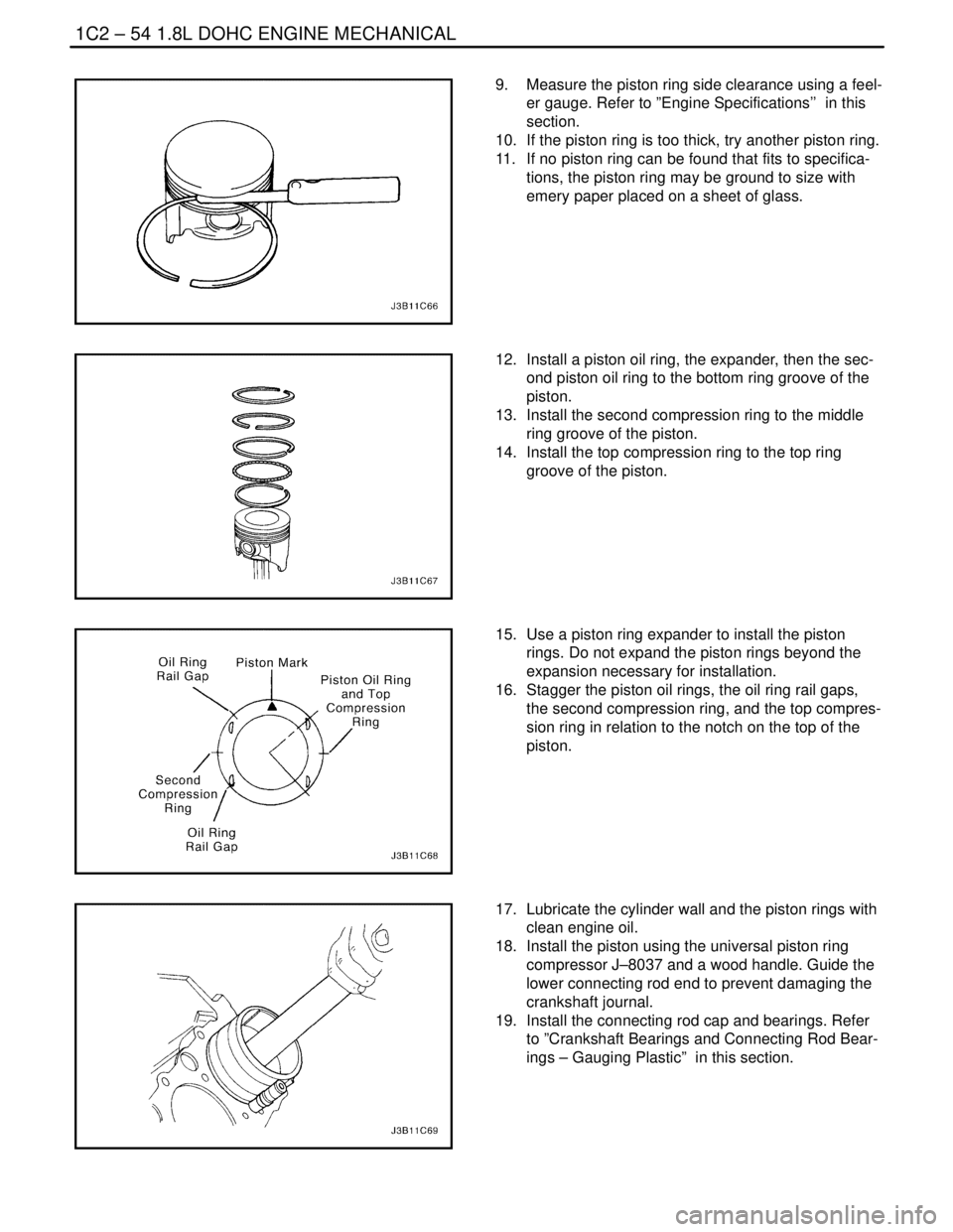2004 DAEWOO NUBIRA ground clearance
[x] Cancel search: ground clearancePage 36 of 2643

1A – 4IGENERAL ENGINE INFORMATION
DAEWOO V–121 BL4
Repairing the Leak
Once the origin of the leak has been pinpointed and traced
back to its source, the cause of the leak must be deter-
mined in order for it to be repaired properly. If a gasket is
replaced, but the sealing flange is bent, the new gasket will
not repair the leak. The bent flange must be repaired also.
Before attempting to repair a leak, check for the following
conditions and correct them as they may cause a leak.
Gaskets:
S The fluid level/pressure is too high.
S The crankcase ventilation system is malfunctioning.
S The fasteners are improperly tightened or the
threads are dirty or damaged.
S The flanges or the sealing surface is warped.S There are scratches, burrs or other damage to the
sealing surface.
S The gasket is damaged or worn.
S There is cracking or porosity of the component.
S An improper seal was used, (where applicable).
Seals:
S The fluid level/pressure is too high.
S The crankcase ventilation system is malfunctioning.
S The seal bore is damaged, scratched, burred or
nicked.
S The seal is damaged or worn.
S Improper installation is evident.
S There are cracks in the component.
S The shaft surface is scratched, nicked or damaged.
S A loose or worn bearing is causing excess seal
wear.
KNOCK DIAGNOSIS
Definition for Knock
Engine knock refers to various types of engine noise.
Heavy knock is usually very loud and the result of broken
or excessively worn internal engine components. Lightknock is a noticeable noise, but not as loud. Light knock
can be caused by worn internal engine components.
Loose or broken external engine components can also
cause heavy or light knock.
Engine Knocks Cold and Continues for Two–Three Minutes and/or
Knock Increases with Engine Torque
StepActionValue(s)YesNo
1Does the engine knock when it is cold and continue
for two to three minutes or does the knock increase
with torque?–Go to Step 2System OK
2Inspect the flywheel.
Is the flywheel contacting the splash shield?–Go to Step 3Go to Step 4
3Reposition the splash shield.
Is the repair complete?–Go to Step 1–
4Inspect the balancer and the drive pulleys.
Is either the balancer or the drive pulleys loose or
broken?–Go to Step 5Go to Step 6
5Tighten or replace the balancer or the drive pulleys.
Is the repair complete?–Go to Step 1–
6Inspect the piston–to–bore clearance.
Is the clearance more than the specified value?0.030 mm
(0.001 in.)Go to Step 7Go to Step 8
71. Rebore the cylinder and hone to size.
2. Replace the piston.
Is the repair complete?*–Go to Step 1–
8Inspect the connecting rod.
Is the connecting rod bent?–Go to Step 9System OK
9Replace the connecting rod.
Is the repair complete?–Go to Step 1–
* Cold engine piston knock usually disappears when the cylinder is grounded out. Cold engine piston knock, which disap-
pears in about 1.5 minutes, is considered acceptable.
Page 37 of 2643

GENERAL ENGINE INFORMATION 1A – 5
DAEWOO V–121 BL4
Heavy Knock Hot with Torque Applied
StepActionValue(s)YesNo
1Is there a heavy knock when the engine is hot and
torque is applied?–Go to Step 2System OK
2Inspect the balancer and the pulley hub.
Is the balancer or the pulley hub broken?–Go to Step 3Go to Step 4
3Replace the broken balancer or the pulley hub.
Is the repair complete?–Go to Step 1–
4Inspect the torque converter bolts.
Are the bolts tightened to specified value?45 NSm
(33 lb–ft)Go to Step 5Go to Step 6
5Tighten the torque converter bolts.
Is the repair complete?–Go to Step 1–
6Inspect the accessory belts.
Are the belts too tight or nicked?–Go to Step 7Go to Step 8
7Replace and/or tension the belts to specifications,
as necessary.
Is the repair complete?–Go to Step 1–
8Inspect the exhaust system.
Is the system grounded?–Go to Step 9Go to Step 10
9Reposition the system, as necessary.
Is the repair complete?–Go to Step 1–
10Inspect the flywheel.
Is the flywheel cracked?–Go to Step 11Go to Step 12
11Replace the flywheel.
Is the repair complete?–Go to Step 1–
12Inspect the main bearing clearance.
Is the clearance more than the specified value?0.026~0.046
mm (0.0010~
0.0018 in.)Go to Step 13Go to Step 14
13Replace the main bearings, as necessary.
Is the repair complete?–Go to Step 1–
14Inspect the rod bearing clearance.
Is the clearance more than the specified value?0.019 ~
0.070 mm
(0.0007 ~
0.0028 in.)Go to Step 15System OK
15Replace the rod bearings, as necessary.
Is the repair complete?–Go to Step 1–
Page 98 of 2643

1.4L/1.6L DOHC ENGINE MECHANICAL 1C1 – 55
DAEWOO V–121 BL4
9. Inspect the engine block deck surface for flatness
using a straight edge and a feeler gauge. Refer to
”Engine Specifications” in this section.
10. Inspect the bearing bore for concentricity and align-
ment using a bore gauge. Refer to ”Engine Specifi-
cations” in this section. If the bearing bore is be-
yond specifications, replace the engine block.
11. Inspect the engine block cylinder bore for wear,
runout, ridging and taper using a bore gauge. Refer
to ”Engine Specifications” in this section.
12. Inspect the engine block cylinder bore for glazing.
Lightly hone the cylinder bore as necessary.
Installation Procedure
1. Align the notch on the piston and the connecting
rod so that the proper sides will be facing the front
of the engine.
2. Install the piston pin guide through the piston and
the connecting rod.
3. Coat the piston pin with clean oil.
4. Install the piston pin into the opposite side of the
piston.
5. Install the piston pin into the piston and connecting
rod assembly using the piston pin service set
KM–427.
6. Select a set of new piston rings.
7. Measure the piston ring gap using a feeler gauge.
Refer to ”Engine Specifications” in this section.
8. Increase the piston ring gap by carefully filing off
excess material if the piston ring gap is below spec-
ifications.
9. Measure the piston ring side clearance using a feel-
er gauge. Refer to ”Engine Specifications’’ in this
section.
10. If the piston ring is too thick, try another piston ring.
11. If no piston ring can be found that fits to specifica-
tions, the piston ring may be ground to size with
emery paper placed on a sheet of glass.
Page 174 of 2643

1C2 – 54I1.8L DOHC ENGINE MECHANICAL
DAEWOO V–121 BL4
9. Measure the piston ring side clearance using a feel-
er gauge. Refer to ”Engine Specifications’’ in this
section.
10. If the piston ring is too thick, try another piston ring.
11. If no piston ring can be found that fits to specifica-
tions, the piston ring may be ground to size with
emery paper placed on a sheet of glass.
12. Install a piston oil ring, the expander, then the sec-
ond piston oil ring to the bottom ring groove of the
piston.
13. Install the second compression ring to the middle
ring groove of the piston.
14. Install the top compression ring to the top ring
groove of the piston.
15. Use a piston ring expander to install the piston
rings. Do not expand the piston rings beyond the
expansion necessary for installation.
16. Stagger the piston oil rings, the oil ring rail gaps,
the second compression ring, and the top compres-
sion ring in relation to the notch on the top of the
piston.
17. Lubricate the cylinder wall and the piston rings with
clean engine oil.
18. Install the piston using the universal piston ring
compressor J–8037 and a wood handle. Guide the
lower connecting rod end to prevent damaging the
crankshaft journal.
19. Install the connecting rod cap and bearings. Refer
to ”Crankshaft Bearings and Connecting Rod Bear-
ings – Gauging Plastic” in this section.
Page 972 of 2643

2E – 10ITIRES AND WHEELS
DAEWOO V–121 BL4
turers of tire chains have a specific chain size for each tire
size to ensure a proper fit when the chain is installed. Be
sure to purchase the correct chains for the tires on which
they are to be used. Use rubber adjusters to take up any
slack or clearance in loose chains.
Use of chains may adversely affect vehicle handling.
When tire chains are installed, follow these precautions:
S Adjust speed to road conditions.
S Avoid sharp turns.
S Avoid locked–wheel braking.
To prevent chain damage to the vehicle, install the chains
on the front tires as tightly as possible. Tighten them again
after driving 0.4 to 0.8 kilometer (0.3 to 0.5 mile). The use
of chains on the rear tires is not recommended because
they may contact the vehicle and possibly damage it. If
chains must be used on the rear tires, be sure there is suffi-
cient clearance between the chains and the body. Do not
exceed 70 km/h (45 mph) or the chain manufacturer’s
speed limit, if lower. Avoid large bumps, potholes, severe
turns and any other maneuvers which could cause the
tires to bounce. Follow any other instructions of the chain
manufacturer which do not disagree with the above in-
structions.
REPLACEMENT TIRES
A tire performance criteria (TPC) specification number is
molded in the sidewall near the tire size of all original
equipment tires. This specification number assures that
the tire meets performance standards for traction, endur-
ance, dimensions, noise, handling and rolling resis–tance.
Usually a specific TPC number is assigned to each tire
size.
CAUTION : Do not mix different types of tires on the
same vehicle such as radial, bias and bias–belted
tires except in emergencies, because vehicle han-
dling may be seriously affected and may result in loss
of control.
Use only replacement tires with the same size, load range,
and construction as the original. The use of any other tire
size or construction type may seriously affect ride, han-
dling, speedometer/odometer calibration, vehicle ground
clearance, and tire clearance to the body and the chassis.
This does not apply to the spare tire furnished with the ve-
hicle.
It is recommended that new tires be installed in pairs on
the same axle.
If it is necessary to replace only one tire, pair it with the tire
having the most tread to equalize the braking action.
Although they may appear different in tread design, tires
built by different manufacturers with identical TPC specifi-
cations may be used on the same vehicle.
ALL SEASON TIRES
Most vehicles are now equipped with steel–belted all sea-
son radial tires as standard equipment. These tires qualify
as snow tires, with a 37 percent higher average rating for
snow traction than the non–all season radial tires pre-
viously used. Other performance areas, such as wet trac-
tion, rolling resistance, tread life, and air retention, have
also been improved. This was done by improvements in
both tread design and tread compounds. These tires are
identified by an ”M + S” molded in the tire sidewall following
the size number. The suffix ”MS” is also molded in the side-
wall after the TPC specification number.
The optional handling tires used on some vehicles are not
all season tires. These will not have the ”MS” marking after
the tire size or the TPC specification number.
PASSENGER METRIC SIZED TIRES
All Daewoo vehicles now use Passenger (P) metric sized
tires. P–metric tires are available in two load ranges: stan-
dard load (35 psi maximum) and extra load (41 psi maxi-
mum). Most passenger vehicle tires are standard load.
Most P–metric tire sizes do not have exact corresponding
alphanumeric tire sizes. For example, a P175/70R13 is
not exactly equal in size and load–carrying capacity to an
FR70–13. For this reason, replacement tires should be of
the same TPC specification number as the originals. If P–
metric tires must be replaced with other sizes, consult a
tire dealer. Tire companies can best recommend the clos-
est match of alphanumeric to P–metric sizes within their
own tire lines.
The metric term for measuring tire inflation pressure is the
kilopascal (kPa). Tire pressure may be printed in both kPa
and psi. One psi equals 6.895 kPa.
See the tire label or refer to ”Tire Size and Pressure Speci-
fications” in this section for tire inflation pressures.
TIRE LABEL
The tire label is permanently located on the rear face of the
driver’s door and should be referred to for tire information.
It lists the maximum vehicle load, the tire size (including
the spare tire), and the cold inflation pressure (including
the spare tire).
SPARE TIRE
The notchback and the wagon come equipped with a full–
sized tire on a steel wheel. The hatchback comes
equipped with a reduced–sized temporary tire on a steel
wheel.
WHEELS
Wheels must be replaced if they are bent, dented, have
excessive lateral or radial runout, leak air through welds,
have elongated bolt holes, or if the wheel bolts won’t stay
tight or are heavily rusted. Wheels with excessive runout
may cause vehicle vibration. Replacement wheels must
be equivalent to the original equipment wheels in load ca-
Page 973 of 2643

TIRES AND WHEELS 2E – 11
DAEWOO V–121 BL4
pacity, diameter, rim width, offset, and mounting configu-
ration. A wheel of improper size or type may affect wheel
and bearing life, brake cooling, speedometer/odometer
calibration, vehicle ground clearance, and tire clearance
to the body and the chassis. The wheel offset is 49 ± 1 mm
(1.93 ± 0.04 inches). Steel wheels may be identified by a
two– or three–letter code stamped into the rim near the
valve stem. Alloy wheels should have the code, the part
number, and the manufacturer ID cast into the back side.
INFLATION O TIRES
The pressure recommended for any vehicle line is careful-
ly calculated to give a satisfactory ride, handling, tread life,
and load–carrying capacity.
Tire pressure should be checked monthly or before any
extended trip. Check the tires when they are cold, after the
vehicle has sat for 3 hours or more, or has been driven less
than 1 mile. Set the tire pressure to the specifications on
the tire label located on the rear face of the driver’s door.
Tire inflation pressure is also given under ”Tire Size and
Pressure Specifications” in this section.
Valve caps or extensions should be on the valves to keep
dust and water out.
For sustained driving at speeds up to 140 km/h (85 mph),
inflate the tires to the pressure recommended on the tire.
Sustained driving at speeds faster than 140 km/h (85mph), even if permitted by law, is not advised unless the
vehicle has special high–speed tires available from many
tire dealers. Tire pressures may increase as much as 41
kPa (6 psi) when the tires are hot.
Higher than recommended tire pressure can cause
S Hard ride.
S Tire bruising or damage.
S Rapid tread wear at the center of the tire.
Lower than recommended pressure can cause
S Tire squeal on turns.
S Hard steering.
S Rapid and uneven wear on the edges of the tread.
S Tire rim bruises and rupture.
S Tire cord breakage.
S High tire temperatures.
Unequal tire pressures on same axle can cause
S Uneven braking.
S Steering lead.
S Reduced handling.
S Swerve on acceleration.
S Torque steer.